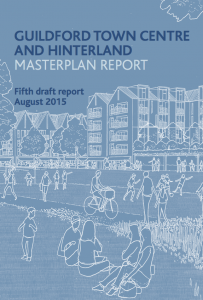 Abraham Lincoln
If given the truth, the people can be depended upon to meet any national crisis...
Abraham Lincoln
If given the truth, the people can be depended upon to meet any national crisis...
 Guildford news...
for Guildford people, brought to you by Guildford reporters - Guildford's own news service
Guildford news...
for Guildford people, brought to you by Guildford reporters - Guildford's own news service
Letter: A Raft Over The Railway Station Is Not Practical
Published on: 29 Oct, 2015
Updated on: 29 Oct, 2015
In response to Julian Lyon’s letter: Guildford Will Need A Strong Leader.
Has Guildford Society sought advice from any firm of consultants about the viability of building a raft over the railway station?
In the early stages, one Network Rail consultant did explore the possibility of a structure over the tracks housing a hotel and other business units.
Network Rail presumably abandoned the idea because of health and safety considerations of building over tracks that only have about three hours between 1:30 and 4:25 am when no trains run.
A raft would require piling and these could only be placed within the platform areas hence a non-starter as far as keeping platforms open safely.
Guildford Society also had a proposal for constructing a forecourt over the tracks on the north side of the station and a one-way system with a view to pedestrianising the station access area but that too, as far as I am aware, was not acceptable to Network Rail.
In 2009 I then proposed a bridge over the tracks and contraflow on the gyratory, as a member of society’s transport group. My idea was to launch this bridge so as to cause least interference with running of the trains. Network Rail was advised of the proposal but they did not respond favourably. A reputable specialist bridge builder informally commented that such a bridge could be built as I had suggested.
The current Solum Regeneration proposal has a large number of housing units and, if deemed appropriate, these could be increased in height a little to gain even more. Of course their main building next to the redesigned station entrance is already too tall and it needs to be lowered a little to achieve an overall balance.
What is of paramount importance is that the route of the bridge/flyover is secured now so that unnecessary waste of resources in perhaps demolishing newly built housing is avoided if decision is delayed.
The bridge shown in Guildford Vision Group’s proposal is roughly in the same place as mine shown in one of the sketches on my website.
The question of bus routes and possibly relocating the bus station in order to conveniently achieve a transport hub at the railway station should also be given priority in the planning process.
Bus bays dotted across the town centre is not the best solution considering connections and ease of use in inclement weather and unfamiliarity of their locations for the occasional visitors. May I humbly suggest that my ideas on this topic as described on my website be carefully considered.
Without creating problems on the west side of the tracks, re-routeing of the Millbrook traffic to avoid the town centre could only be done, by either constructing a flyover or by tunnelling the road through to Onslow Street. A flyover would destroy the town’s character and so the only really viable option is to go underground.
Time has come to consider these issues seriously rather than expressing hopes that somehow a modal shift of road usage into more walking and cycling would reduce traffic problems. Practical and pragmatic solutions are urgently required.
Responses to Letter: A Raft Over The Railway Station Is Not Practical
Leave a Comment Cancel reply
Please see our comments policy. All comments are moderated and may take time to appear. Full names, or at least initial and surname, must be given.
Click on cartoon for Dragon story: Public Asked for Views on SCC’s Proposal for Reduced Speed Limits






Recent Articles
- Notice: Cut It Out!
- Stoke Park Was Bought 100 Years Ago with Plans for a Public Open Space and Houses!
- Dragon Review: The Pajama Game – Yvonne Arnaud Theatre
- A Hidden Gem in the Hills: Michelin-Backed William IV Pub Brings Refined Dining to Albury
- Letter: Help Reduce Speeding By Joining a Community Speedwatch Team
- Hospital Apologises ‘Unreservedly’ After Death of Disabled Girl
- Birdwatcher’s Diary No.328
- SCC Intends to Back Public Survey Result and Shorten Summer School Holidays
- A281 Expected to Remain Closed Until Repairs to Damaged Cottage Are Completed
- Surrey Heath Selling Assets to Maintain Essential Services


Recent Comments
- Philip Camp on A Look Back at Perry Hill’s New Inn and a Family That Once Ran It
- RWL Davies on Community Councils Proposed to Maintain Local Representation
- Stephen Spark on Major Disruption on the Railway During Hot Day in 1900
- Jim Allen on Community Councils Proposed to Maintain Local Representation
- Jeremy Holt on Community Councils Proposed to Maintain Local Representation
- Lisa Land on Birdwatcher’s Diary No.328
Search in Site
Media Gallery
Dragon Interview: Local Artist Leaves Her Mark At One of England’s Most Historic Buildings
January 21, 2023 / No Comment / Read MoreDragon Interview: Lib Dem Planning Chair: ‘Current Policy Doesn’t Work for Local People’
January 19, 2023 / No Comment / Read MoreA3 Tunnel in Guildford ‘Necessary’ for New Homes, Says Guildford’s MP
January 10, 2023 / No Comment / Read More‘Madness’ for London Road Scheme to Go Ahead Against ‘Huge Opposition’, Says SCC Leader
January 6, 2023 / No Comment / Read MoreCouncillor’s Son Starts Campaign for More Consultation on North Street Plan
December 30, 2022 / No Comment / Read MoreCounty Council Climbs Down Over London Road Works – Further ‘Engagement’ Period Announced
December 14, 2022 / No Comment / Read MoreDragon Interview: GBC Reaction to the Government’s Expected Decision to Relax Housing Targets
December 7, 2022 / No Comment / Read MoreHow Can Our Town Centre Businesses Recover? Watch the Shop Front Debate
May 18, 2020 / No Comment / Read More







Julian Lyon
October 30, 2015 at 7:56 am
With the greatest respect to Bibas Neoghi, this is not a Guildford Society proposal. I have carefully worked through a methodology in the context of the Network Rail Wessex Plan whereby at very few stages would any construction take place over working rails.
The key components are:
– rebuilding Yorkies Bridge (University of Surrey to Walnut Tree Close) to serve as a diversion for the Farnham Road whilst the works are undertaken (this would be necessary to replace the Farnham Road Bridge which is already earmarked for reconstruction by Network Rail in the next 10-20 years.
– constructing a new platform 0 for suburban services starting and ending in Guildford – this and a proposed increase in suburban services frees up the through lines at platform 2 and 3.
– closing the two westernmost lines and building the station extension envisaged in the Wessex Plan (perhaps with slightly different configuration to accommodate columns) and building a raft over the top at Guildford Park Road height (remember no trains are running beneath these works at this stage.
– opening the new lines and closing the existing platforms 2-5 to construct a raft over these platforms (which would not then have trains running through them)
By 2024, the station could then be reopened fully, as planned in the Wessex Plan, with the raft in place and whatever road system was required could be accommodated on the raft – Farnham Road Bridge, new York Road extension, etc.
At the very least this would reunite east and west Guildford and provide permeability through a new residential development just where we need it to be – in the town centre.
The key design issue will be getting the heights right to preserve and protect views to and from the hstoric town centre.
The game changer is the coming together of a tangible desire for a crossing coupled with Network Rail’s own plans to expand the station and taken alongside a brownfield site initiative and a major housing shortfall.
Let’s be bold and seize the moment – and, just for the record, this concept has not (yet at least) been adopted by the Guildford Society or Guildford Vision Group, so it remains a concept that I am working on.
Julian Lyon is the chairman of the Guildford Society commenting here in his personal capacity.
Robert Burch
October 30, 2015 at 2:10 pm
Can Mr Neogi explain how the substantial buildings over Charing Cross and Wimbledon stations were constructed?
How was this work “practical” but doing something similar in Guildford would not be?
Adrian Atkinson
October 30, 2015 at 5:37 pm
Similar view with regards to not being able to engineer water solutions which other countries and towns have done so relatively easily to increase the potential of areas like Walnut Tree Close
As Muhammad Ali said: “Impossible is just a big word thrown around by small men who find it easier to live in the world they’ve been given than to explore the power they have to change it. Impossible is not a fact. It’s an opinion. Impossible is not a declaration. It’s a dare. Impossible is potential. Impossible is temporary. Impossible is nothing.”
Bibhas Neogi
October 31, 2015 at 7:37 pm
In response to Robert Burch – I have had no involvement with these works, so I cannot comment regarding how or what was constructed safely over the tracks.
Looking at the information available on the internet, I got the impression that the new works at these two stations were mainly to do with roof coverings.
Roof coverings are usually much lighter structures and could be constructed using cranes lifting manageable components into place and welding or bolting them up to form the bigger structure.
A raft capable of carrying buildings and roads above them is a different matter altogether and constructing them safely over the tracks could only be done when tracks are taken out of service and the proximity of cranes and piling rigs to remaining live tracks are outside the limit set by Network Rail’s design rules for safety, for example, if they accidentally topple over.
Therefore constructing a raft over the tracks at Guildford may not be a practical even where Julian Lyon’s ideas are concerned.
I am not a railway engineer but I appreciate that constructing offset lines require transition curves on both sides of the straight length of the platforms as to where the points and crossings in the rails have to be provided. I do not know if adequate length is available to do this considering that connections of the new tracks have to be with the existing adjacent tracks within the stretch of their own points and crossings.
In response to Adrian Atkinson – I said it was not practical to construct a raft. It implies that this is a difficult challenge and not a cost-effective solution to go for.
Impossible? Maybe not, but how much money has to be thrown to achieve this is the big question.
If building a raft was a viable and profitable option why ins’t Solum Regeneration doing it? I said earlier that a Network Rail consultant had come up with the idea of a raft and buildings on it but this had not been taken forward by Network Rail.
Perhaps they should be asked for their reasons for not progressing with such ideas?